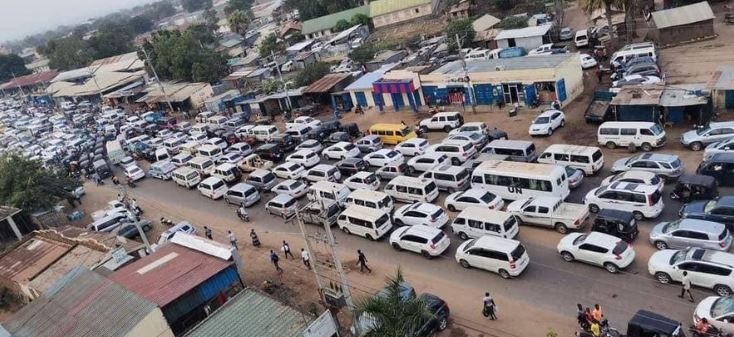BY: EMMANUEL TABAN PETER
South Sudan’s Ministry of Interior deserves recognition for some of the good work it has done in Juba City in terms of tracking criminals using the installation of closed-circuit television (CCTV) cameras in some parts of the city.
This is a good start towards stabilizing security and enhancing development as well. The remaining streets can be connected later. However, the ministry should think of restoring the traffic lights in the city and also marking pedestrian walkways to save lives by reducing accidents.
Currently, the rate of accidents is skyrocketing in Juba because there are no designated pedestrian’ walking walkways. Pedestrians often cross at busy road sections and some reckless drivers who do not know or observe traffic laws just hit them. These incidents are very common during rush hour in the morning and evening and the most affected are children going to and or returning from school. A number of them were been knocked dead and others hospitalized.
Most of the reckless drivers normally escape and cannot be arrested or located, especially where there are no CCTV cameras to capture the footage of the incidents, and tracing them becomes a challenge.
My opinion is that the interior minister must prioritize the installation of traffic lights and increase the number of CCTV cameras in all streets of Juba. CCTV security is effective in preventing burglaries, home invasions, and robberies, and it can also act as a deterrent against theft. Apart from preventing criminal activity, CCTV security offers numerous other benefits. It can protect against workplace violence, monitor private or sensitive areas, and safeguard trade secrets, including curbing sexual harassment in the workplace.
Crime prevention
CCTV systems must be installed and used in compliance with the law, and their use should be transparent and open to public scrutiny. Nonetheless, CCTV security remains an effective tool in protecting people and property, and it is likely to continue to be an important feature of public and private security systems.
Pedestrian crossings are not simply points of intersection on vehicle routes; they are vital spaces for the mobility and safety of people. In urban and road contexts where vehicle traffic is intense, pedestrians often find themselves in vulnerable situations. In this context, the concept of “safe pedestrian crossings” becomes highly relevant, as they can be considered fundamental elements in promoting more inclusive mobility and environmental respect.
The safety of pedestrians and cyclists at these crossings should be a priority in urban designs to protect the most vulnerable users and to promote a shift in mobility culture, encouraging more active and environmentally respectful forms of travel.
Elevated crossings and pedestrian bridges
These crossings are built above street level and are especially useful in high-traffic areas or main roads. Their advantages include; completely separating pedestrians and vehicles so that the chances of accidents are significantly reduced. They do not interrupt vehicle flow and include ramps or elevators for people with disabilities.
Improving visibility, for both pedestrians and drivers and road safety education from an early age is crucial, especially to instill in children the importance of respecting traffic signals and using pedestrian crossings correctly. Likewise, it is essential to adopt specific measures to protect older adults, who are often more vulnerable to pedestrian accidents.
Shared responsibility between drivers and pedestrians plays a key role in this effort. Drivers must always be attentive to pedestrians, respect speed limits, and yield at pedestrian crossings. On the other hand, pedestrians must ensure they cross streets safely, using designated crossings and following traffic signals. Road safety is everyone’s responsibility.
Proper and adequate lighting at crossings significantly improves visibility for both pedestrians and drivers, especially at night or in low-light conditions. Removal of visual obstructions and ensuring that crossings are free of obstacles such as trees, signs, or parked vehicles that may obscure pedestrians also saves lives.
Driving on the wrong side of the road
We like violating traffic rules and regulations, so, the interior ministry, through the traffic police, should embark on advocating and educating road users on the need to respect the traffic rules and regulations. People like driving in the opposite direction for avoidable reasons. And at times this happens when the traffic police are watching. Driving on the wrong side contributes to traffic jams and there is a need to restrict those kinds of violations.
We expect all of our law enforcing agents to practice and respect the laws of our beloved country and we should be seen demonstrating professionalism on the streets and in public places. It is very unwise not to respect traffic police officers.
Let us go for installing traffic lights, building pedestrian crossing bridges, or a simple marking of the crossing ways to help pedestrians.
We all understand the economic challenges including the limited resources we have in the country, but out of the little collections we get, let the interior ministry and Juba City Council plan and allocate some funds to save lives.
The author is pursuing a Master of Science in Procurement & Supply Chain Management and is a holder of a CPA in Finance and Accounting. He can be reached via emmanueltabanpeter3@gmail.com or +211928272350.
The views expressed in ‘opinion’ articles published by Radio Tamazuj are solely those of the writer. The veracity of any claims made is the author’s responsibility, not Radio Tamazuj’s.




